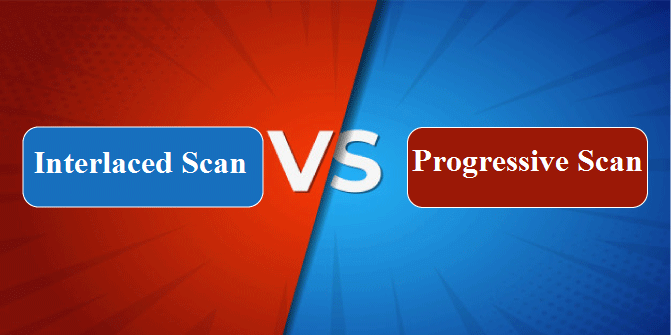Difference between Interlaced and Progressive ScanInterlaced and progressive scans are raster scanning methods that are both widely employed in analogue video systems. The primary distinction between these scans is that the interlaced scan uses scanning of even and odd marked lines of an image, which are shown sequentially as two separate fields superimposed to display one frame on the screen. In contrast, the progressive scan uses a single sweep over the entire picture at a time. In this article, you will learn about the difference between an Interlaced and Progressive scan. But before discussing the differences, you must know about Interlaced and progressive scans with their advantages and disadvantages. What is Interlaced Scanning?Interlaced scanning is a raster scanning method in which a picture is scanned by dividing a single frame into two fields. These components are known as fields. Each field is called a 2:1 interlace because it comprises half of the lines in the frame. The field interval is the time period between two fields that is equal to half of the frame interval. The two fields are referred to as "top field" and "bottom field" in MPEG specifications. The top field contains the first line and the alternate lines that follow. On the other hand, the bottom field contains the second set of alternate lines. The main drawback of interlaced scanning is "combing", which reduces video quality. In interlaced videos or images, the combing effect creates zig-zag artefacts. The interlaced scan was popular in the beginning since it used less bandwidth. Interlaced scanning was popular in the beginning because it uses less bandwidth, which improves temporal resolution and minimizes flickering. Previously, the channels were disseminated via televisions that used data hurled over the airways or coax cable. Interlaced videos save bandwidth by only delivering half of a complete frame at a time, which was useful for boosting refresh rate and providing smoother action on older TV sets. Advantages and Disadvantages of Interlaced ScanThere are various advantages and disadvantages of an Interlaced scan. Some main advantages and disadvantages of an Interlaced scan are as follows: Advantages
Disadvantages
What is Progressive Scan?Progressive scanning is a scanning method in which a picture is scanned in a single pass successively. It employs an electron beam that constantly scans the image region from top to bottom. It is more effective than interlaced scanning because progressive scanning scans the picture frame by frame. In addition, progressive scanning has no combing effect. As a result, the video generated by progressive scanning is of large quality. As a result, progressive scanning is preferred over interlaced scanning. The progressive scans may clearly record and display images of fast-moving objects. Another major benefit of progressive scan is that the playing speed of a video is nearly doubles that of the interlaced scan. Advantages and Disadvantages of Progressive ScanThere are various advantages and disadvantages of the Progressive Scan. Some main advantages and disadvantages of Progressive Scan are as follows: Advantages
Disadvantages
Key differences between Interlaced Scan and Progressive Scan
There are various key differences between the Interlaced Scan and Progressive Scan. Some of the key differences between Interlaced Scan and Progressive Scan are as follows:
Head-to-head comparison between Interlaced Scan and Progressive ScanHere, you will learn the head-to-head comparisons between the Interlaced Scan and Progressive Scan. The main differences between Interlaced Scan and Progressive Scan are as follows:
ConclusionThe raster scan methods include interlaced and progressive scans, with progressive being a more recent development and interlaced being an older but still used technique. Progressive video scanning and production are more expensive than interlaced, but the results are sharper. The most important distinction to make here is that progressive scan performs scanning of the whole frame in a single pass. In contrast, an interlaced scan is scanned by splitting a single frame into two fields.
Next TopicDifference between
|
 For Videos Join Our Youtube Channel: Join Now
For Videos Join Our Youtube Channel: Join Now
Feedback
- Send your Feedback to [email protected]
Help Others, Please Share










